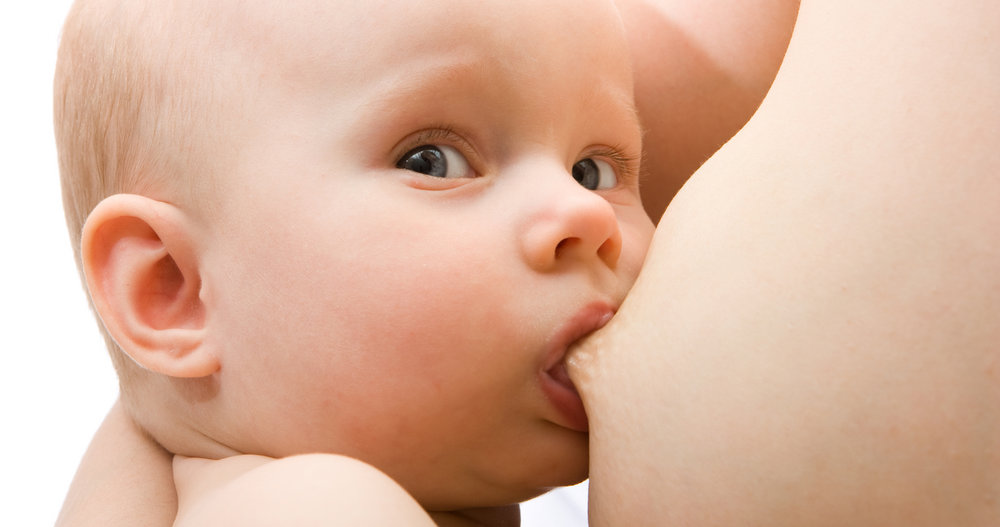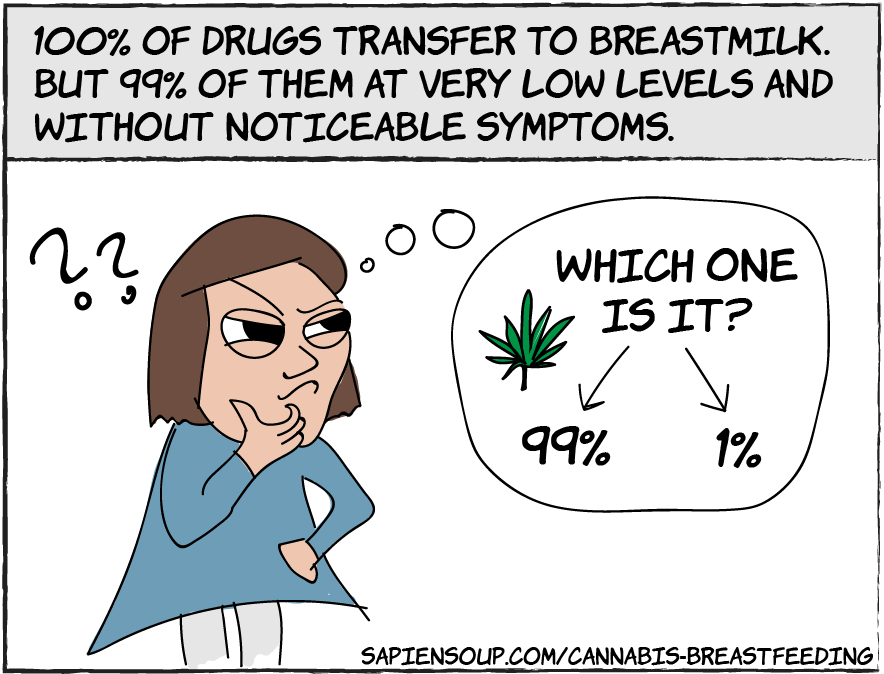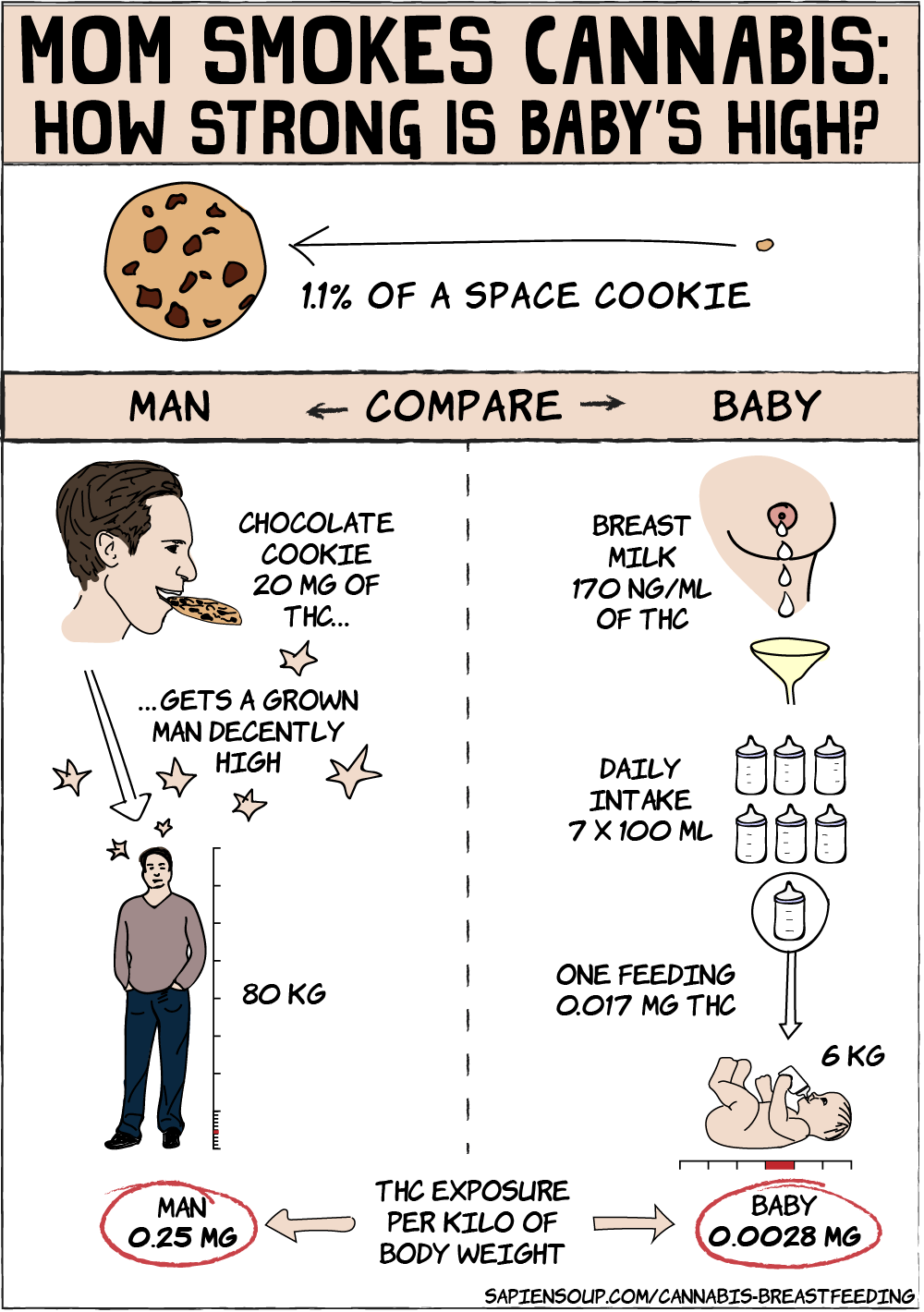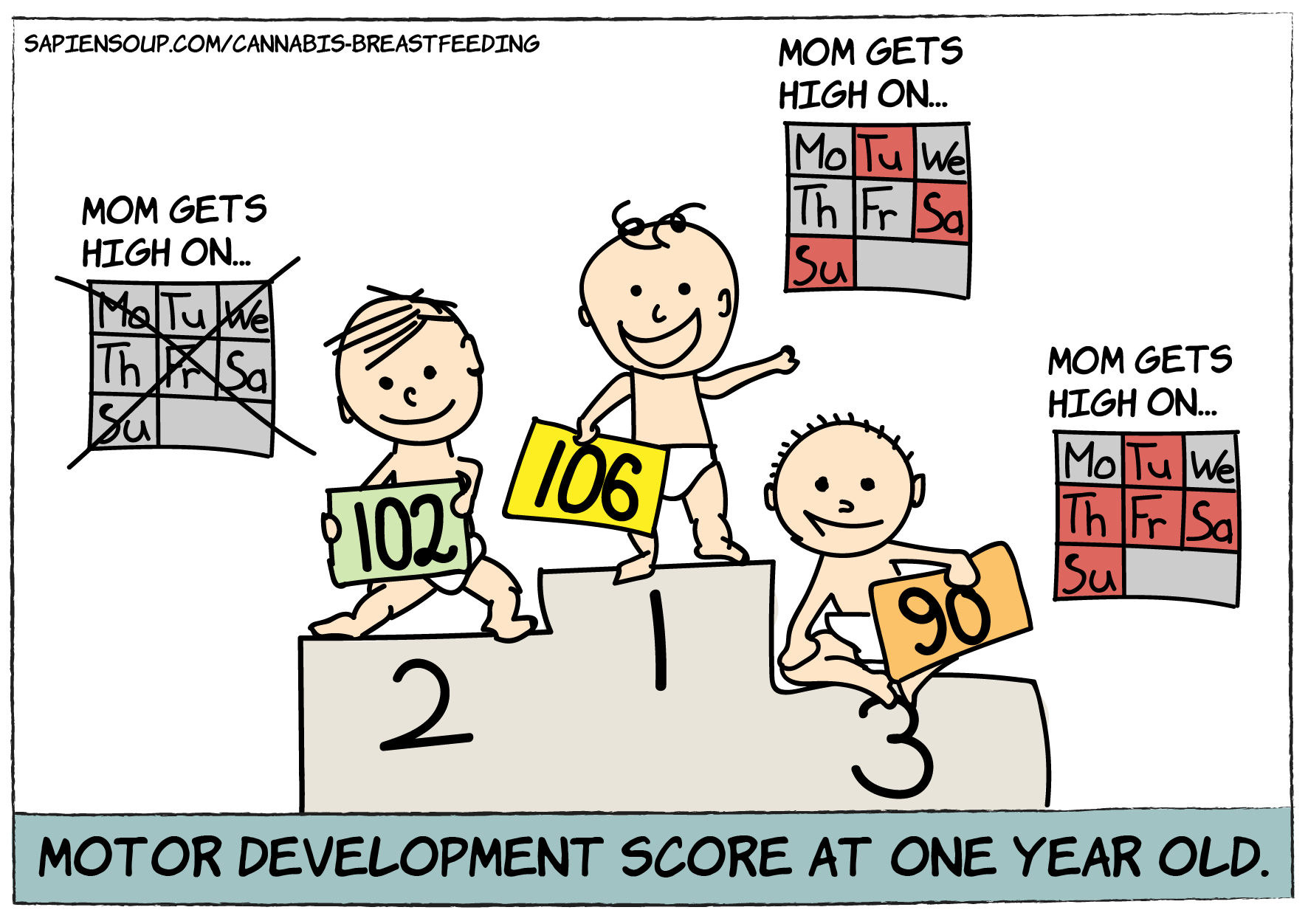How much THC makes it into breast milk? Can it get a baby “high”? What are the long-term effects on the child?
Update: also check out our latest post on this topic: Only small amounts of THC transfer into breast milk, that includes most recent scientific findings from April, 2018.

I nursed my daughter for almost two years. You bet, I had a glass of wine from time to time. I knew how long it would take my body to clear the alcohol so that—after a couple of hours—I could feed again without exposing my child to any risk. But with cannabis, nursing mothers are pretty much groping in the dark.
With cannabis, nursing mothers are pretty much groping in the dark.
Marijuana is legal in half of the States in the US and legal-ish in 16 other countries around the world. And mothers out there are wondering under which circumstances medical or recreational cannabis use is safe while breastfeeding.
The official guideline is that breastfeeding women should not use cannabis. This is because not enough is known about the topic to state “safe amounts” to mothers. I wasn’t satisfied with that answer, so I kept on digging. Here, I’ll present an overview of the scientific facts, so that you can make up your own mind.
Let’s break the topic down into two questions:
I. How much THC makes it into breast milk?
II. What are the effects on the child?
I recommend reading my post on the Human Metabolism of THC. Knowing about how THC—the main active ingredient in cannabis—is metabolized will increase your understanding of the topic. For those in a hurry: at minimum check the infographic and use it as a cheat sheet.
We will deal with very small numbers. A quick refresher on the notation and conversion of grams, milligrams and nanograms:
| g = gram | 1 g = 1,000 mg |
| mg = milligram | 1 mg = 1,000,000 ng |
| ng = nanogram | 1 ng = 0.000000001 g |
I. How much THC makes it into breast milk?
“It is generally accepted that all medications transfer into human milk to some degree, although it is almost always quite low. Only rarely does the amount transferred into milk produce clinically relevant doses in the infant.” reads the introduction to the reference book Medication and Mothers’ Milk.1 It is widely used in American hospitals to determine contraindications of drugs for breastfeeding mothers. The chapter on THC is short and doesn’t contain original research. Yet.

Dark Age of Data
There is little data published on THC levels in mother’s milk. Most data is from the 1970s and 80s. A study from the 70s found that in monkeys only 0.2% of the ingested THC by the mother gets into the breast milk.2
How about humans?
Hard to believe, but there is only one study (!) in which two samples (!) of human breast milk were analyzed.3 The two mothers were heavy users and their milk showed THC levels of 105ng/ml and 340ng/ml.4
Those two data points are interesting, but don’t answer the question how much THC makes it into breast milk because:
- We don’t know how much marijuana was initially consumed.
- We don’t know how long since the last marijuana consumption.
- With a one-time measurement we don’t see how the THC concentration in breast milk behaves over 24 hours.
- Both mothers were heavy users who were consuming marijuana on a daily basis. With regular use, THC accumulates in the body over time, especially in fat. And there is a lot of fat in breast milk. We don’t know which part of the detected THC is due to accumulation and which part is recently consumed THC.
- A sample size of two isn’t representative for a larger population.
True? There is eight times more THC in breast milk than in blood?
This 8:1 ratio has spread across the internet. Beware every author who quotes that number as if it were a fact—they’ve got the story wrong. Here is what actually happened:
Once upon a time in 19823, there was one cannabis smoking mother who agreed to have her blood and breast milk analyzed simultaneously for THC. She was a heavy user, smoking marijuana out of a pipe seven times per day. About one hour after her last consumption the researchers took a sample of her blood and breast milk. It turned out, THC levels in her breast milk were eight times higher than in her blood.
But one sample is not representative for a larger population, nor was it the goal of the study. The study’s goal was to find out if THC was present in human breast milk at all and if so, whether it was going to be metabolized in the child. (The answer to both questions is yes.)
The 8:1 ratio was solely an observation regarding that particular case of the heavy using mother. In my eyes, those researchers are heroes for collecting and sharing that data. But they would surely not approve people quoting that 8:1 ratio out of context.
In short: that study did not find that the THC concentration in milk is 8:1 compared to blood. This ratio was true for one case and one case only.
Here are the claims actually supported by science:
- THC blood levels have proven to be highly variable across subjects.
- THC blood levels drop soon after consumption because THC is rapidly taken up by fat tissue. It’s plausible therefore that THC levels would be higher in milk because of its high fat content.
- Recreational users clear their systems faster.
Quick-and-dirty math
Don’t you want to know how high that baby above got from the THC infused breast milk? I was curious and did the math. Turned out, in one feeding baby experienced about 1.1 percent of what an adult would experience if he ate a weed cookie. In other words:
The baby experienced the equivalent of a space cookie’s crumb.

Why didn’t I compare it to the mom’s marijuana pipe? Because (1) the data doesn’t exist and (2) eating cannabis is very different to smoking it. Hence, I believe it’s a more accurate comparison if we stick to the same metabolic pathway through the stomach. From another study5 we know that 20mg of ingested THC produce a decent psychological effect in an adult man. I compared that to a 3 months old baby. The results vary according to how you set the parameters.6 Other authors came close but arrive at slightly different conclusions, e.g. Bennett who landed at a baby’s dose of 0.8 percent of the maternal intake of one joint (per feeding).7
Be that as it may—half a crumb or three—you get an idea about the magnitude we’re operating at. Keep in mind however, that a new crumb is added to the pile every time the baby feeds. The crumbs are getting smaller but we don’t know how fast. To my knowledge there is no study examining the rate of THC elimination from breast milk and that’s precisely the problem.
Not knowing how fast THC clears from breast milk is what’s keeping responsible mothers from a responsible use of cannabis.
II. What are the effects on the child?
The entire academic discussion revolves around two studies which present inconsistent results:
One study8 from 1985 found no effects. The other identified slightly reduced motor development in kids of frequent users.9 That was only true if the mother consumed cannabis in the first month after birth and more frequently than 15 days per month. At one year old, those kids scored more poorly than the kids of non-users.10 However, those results can’t be distinguished from cannabis use during pregnancy; 84% of the mothers who used cannabis while breastfeeding had done so during pregnancy too.11
Ironically, the kids whose mothers used cannabis less than 15 days per month scored higher than the kids of non-users. The narrow lead wasn’t statistically significant though, which means that there was no difference between kids of occasional users and non-users. Furthermore, no differences in mental development were detected amongst any of the three groups.

Summary
Very little amounts of THC get transferred into breast milk. Scientific publications give examples of 0.8 percent of the maternal intake of one joint per feeding7 or a total daily intake of 0.01 to 0.1 milligrams of THC through breastmilk if the mother smokes 1 or 2 cannabis cigarettes per day.12 The particular circumstances under which those numbers were gathered should be kept in mind though:
Potency of marijuana
Over the past 35 years, marijuana has evolved. The study3 most authors refer to was conducted in the early 80s, when the average concentration of THC was at 3.2 percent. Until 2008, it had risen to 8.5 percent.13 In Colorado the average potency of flower (i.e. buds) in 2015 was at 17.1 percent THC.14
Occasional vs. regular use
The few samples analyzed all came from mothers who smoked on a daily basis. With regular use, THC accumulates in fat deposits, from where it is slowly released back into the bloodstream. That’s why the half-life of THC is longer in regular users. Recreational users show lower THC levels in blood and urine and clear it faster from their systems. How fast THC is cleared from specifically breast milk has not been researched yet.
Potential risk for child
Whether the transferred THC has adverse effects on the child is controversial. (Thin) evidence supports both sides of the argument. Heavy cannabis use in the first month of life might result in inferior motor skills at one year old. But that could also be a result of regular cannabis exposure during the preceding pregnancy.
Weighed against benefits of breastfeeding
On the other hand, the benefits of breastfeeding for mother and child are well documented: optimal nourishment, protection against infections, increased IQ, less obesity, reduced risk of ovarian and breast cancer, the list goes on.15
Traditionally, nursing mothers were advised to stop breastfeeding if they wanted to consume cannabis. In recent years, however this position has weakened. The strong health benefits of breastfeeding have led many lactation professionals towards a more moderate benefit/risk calculation.16 Especially with moderate or occasional use, evidence of detrimental effects of cannabis for the child has yet to be presented. Some doctors even go as far as to say that occasional or low regular use while breastfeeding will probably not be of relevance to the child’s development.17
My take on the topic
Don’t judge
I believe the reasons why a nursing mother would decide to consume cannabis are personal and complex. Furthermore, I believe that most mothers care deeply for their baby and wouldn’t make such a decision lightly.
Personally, I was scared of consuming marijuana while breastfeeding and refrained from even taking an aspirin. But also, I didn’t have the information I have today. Maybe today my decision would be different.
Rather, provide information
I’m not a doctor and this isn’t medical advice. Having said that, here is what I personally found to be useful from studying scientific literature:
Eating vs. smoking. Ingesting cannabis produces a similar high but at a considerably lower THC exposure. Start small.
Side stream smoke. Side stream smoke poses a risk to anyone, including you and your baby. Besides THC it holds carcinogens and other toxins.
Backstop. Have someone sober around who can take over with the child if needed. With varying potency of product, effects can be unpredictable. Especially casual users can experience paranoia or impaired judgement. Caring for a child in such a case can be difficult.
Timing matters. During pregnancy and the first three months of life, a baby’s developing organism is most vulnerable. During that time keep exposure to a minimum.
Minimum effective dose (MED). The less, the better – true for almost anything.
References
-
Hale TW, Rowe HE. 2016. Medications & Mothers’ Milk 2017. 17th edition. Springer Publishing Company. ↩
-
Chao FC, Green DE, Forrest IS, et al. The passage of 14C-delta-9-tetrahydrocannabinol into the milk of lactating squirrel monkeys. Res Commun Chem Pathol Pharmacol. 1976 Oct;15(2):303-17. PubMed PMID: 824699. ↩
-
Perez-Reyes M, Wall ME. Presence of delta9-tetrahydrocannabinol in human milk. N Engl J Med. 1982 Sep 23;307(13):819-20. PubMed PMID: 6287261. ↩ ↩2 ↩3
-
Mother 1: 105 ng/ml and negative for metabolites. Mother 2: 340 ng/ml, 11-OH-THC 4 ng/ml, no 11-COOH-THC ↩
-
Hollister LE, Gillespie HK, Ohlsson A, Lindgren JE, Wahlen A, Agurell S. Do plasma concentrations of delta 9-tetrahydrocannabinol reflect the degree of intoxication? J Clin Pharmacol. 1981 Aug-Sep;21(8-9 Suppl):171S-177S. PubMed PMID: 6271822. ↩
-
Results may differ according to assumed parameters such as volume of milk intake, weight of baby, weight of man and amount of THC in cookie. My assumptions were: (1) Breastmilk contains 170 nanograms of THC per milliliter (i.e. average of the three measurements from the 1982 study: 60.3 ng/ml, 105 ng/ml and 340 ng/ml). (2) a daily intake of 700 milliliters (33.7 fl oz). (3) divided over 7 feeding sessions. (4) baby’s weight: 6 kilograms (13.2 lbs). (5) the adult man’s weight: 80 kg (176.4 lbs) which was the average when the study was run. (6) THC in cookie: 20 mg (20 mg of THC per cookie may be considered “mild” nowadays. The potency of cannabis has multiplied since the 1980s and off-the-shelf edibles often come generously dosed.) ↩
-
Bennett PN. Cannabis. Bennett PN and the WHO Working Group, editors. Drugs and human lactation. 2nd ed. 1997. ↩ ↩2
-
Tennes K, Avitable N, Blackard C, et al. Marijuana: prenatal and postnatal exposure in the human. NIDA Res Monogr. 1985;59:48-60. PubMed PMID: 3929132. ↩
-
Astley SJ, Little RE. Maternal marijuana use during lactation and infant development at one year. Neurotoxicol Teratol. 1990 Mar-Apr;12(2):161-8. PubMed PMID: 2333069. ↩
-
Average scores: kids of mothers consuming cannabis more than 15 days per month (90), less than 15 days per months (106), no cannabis at all (102) ↩
-
Metz TD, Stickrath EH. Marijuana use in pregnancy and lactation: a review of the evidence. Am J Obstet Gynecol. 2015 Dec;213(6):761-78. PubMed PMID: 25986032 ↩
-
Grotenhermen F. Clinical Pharmacokinetics of Cannabinoids. Journal of Cannabis Therapeutics, Vol. 3(1) 2003. Link to PDF ↩
-
National Center for Natural Products Research. Quarterly report: Potency Monitoring Project, Report 104, December 16, 2008, thru March 15, 2009. Link to PDF ↩
-
Orens A. Light M. RowberryJ. Et al. Marijuana Equivalency in Portion and Dosage. Colorado Department of Revenue. August 10, 2015 Link to PDF ↩
-
WHO on breastfeeding ↩
-
Bergeria CL, Heil SH. Surveying Lactation Professionals Regarding Marijuana Use and Breastfeeding. Breastfeeding Medicine. 2015;10(7):377-380. PMCID: PMC4692106 ↩
-
FAQ with Dr. Franjo Grotenhermen ↩
